TOYOTA RAV4 2010 XA30 / 3.G Owners Manual
Manufacturer: TOYOTA, Model Year: 2010, Model line: RAV4, Model: TOYOTA RAV4 2010 XA30 / 3.GPages: 513, PDF Size: 9.05 MB
Page 441 of 513
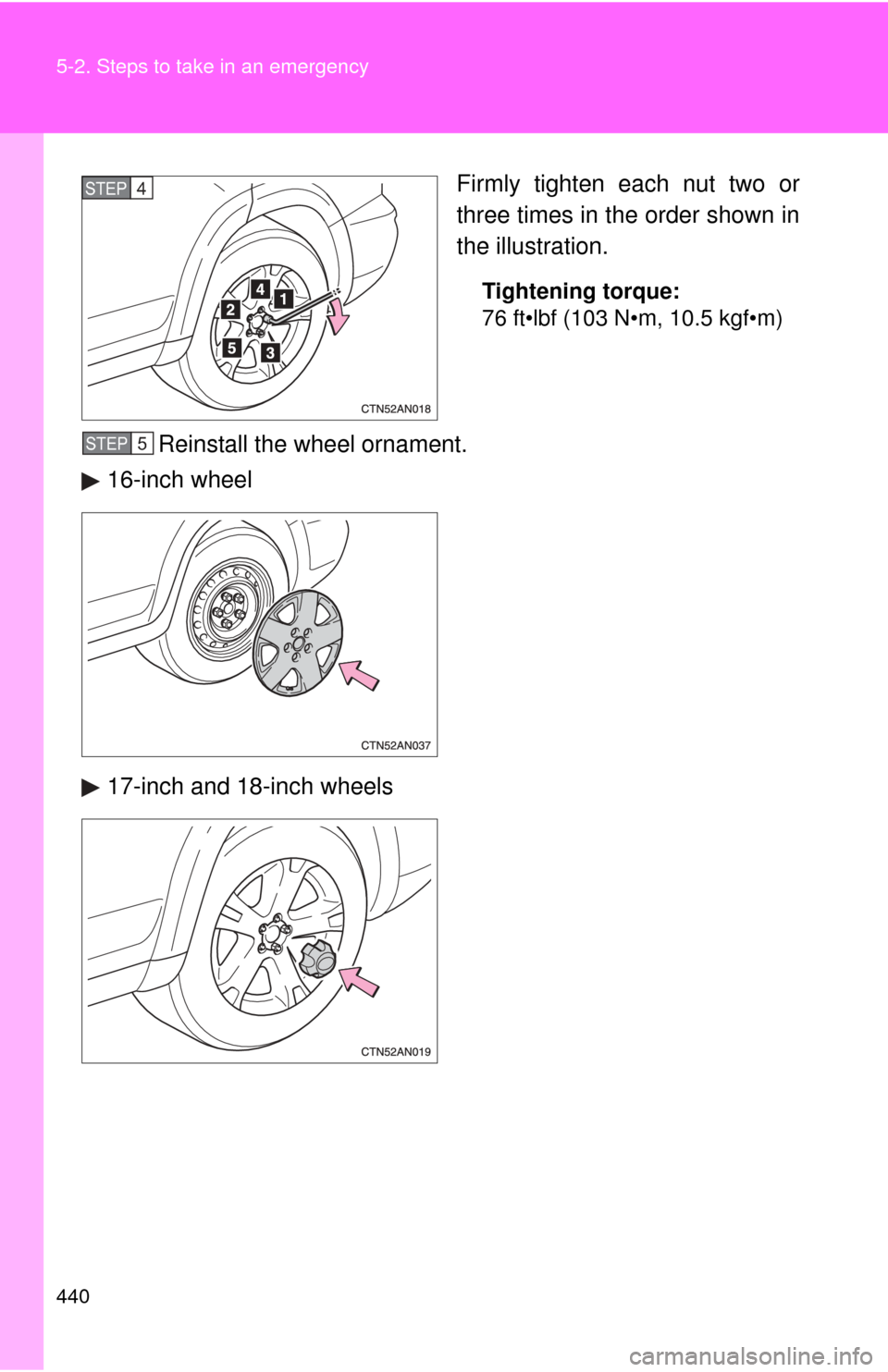
440 5-2. Steps to take in an emergency
Firmly tighten each nut two or
three times in the order shown in
the illustration.
Tightening torque:
76 ft•lbf (103 N•m, 10.5 kgf•m)
Reinstall the wheel ornament.
16-inch wheel
17-inch and 18-inch wheels
STEP 4
STEP 5
Page 442 of 513
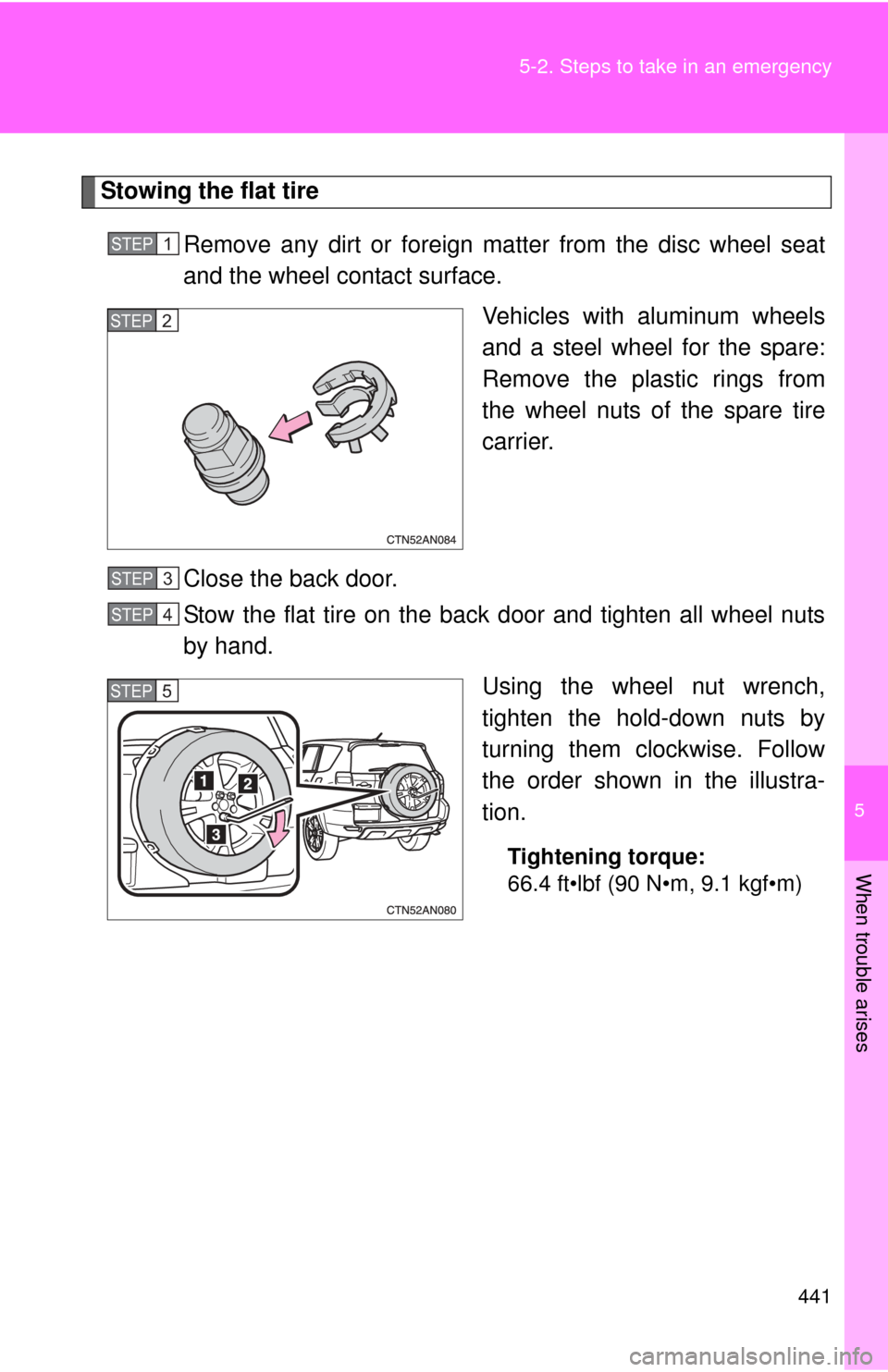
5
When trouble arises
441
5-2. Steps to take in an emergency
Stowing the flat tire
Remove any dirt or foreign matter from the disc wheel seat
and the wheel contact surface. Vehicles with aluminum wheels
and a steel wheel for the spare:
Remove the plastic rings from
the wheel nuts of the spare tire
carrier.
Close the back door.
Stow the flat tire on the back door and tighten all wheel nuts
by hand. Using the wheel nut wrench,
tighten the hold-down nuts by
turning them clockwise. Follow
the order shown in the illustra-
tion.
Tightening torque:
66.4 ft•lbf (90 N•m, 9.1 kgf•m)
STEP 1
STEP 2
STEP 3
STEP 4
STEP 5
Page 443 of 513
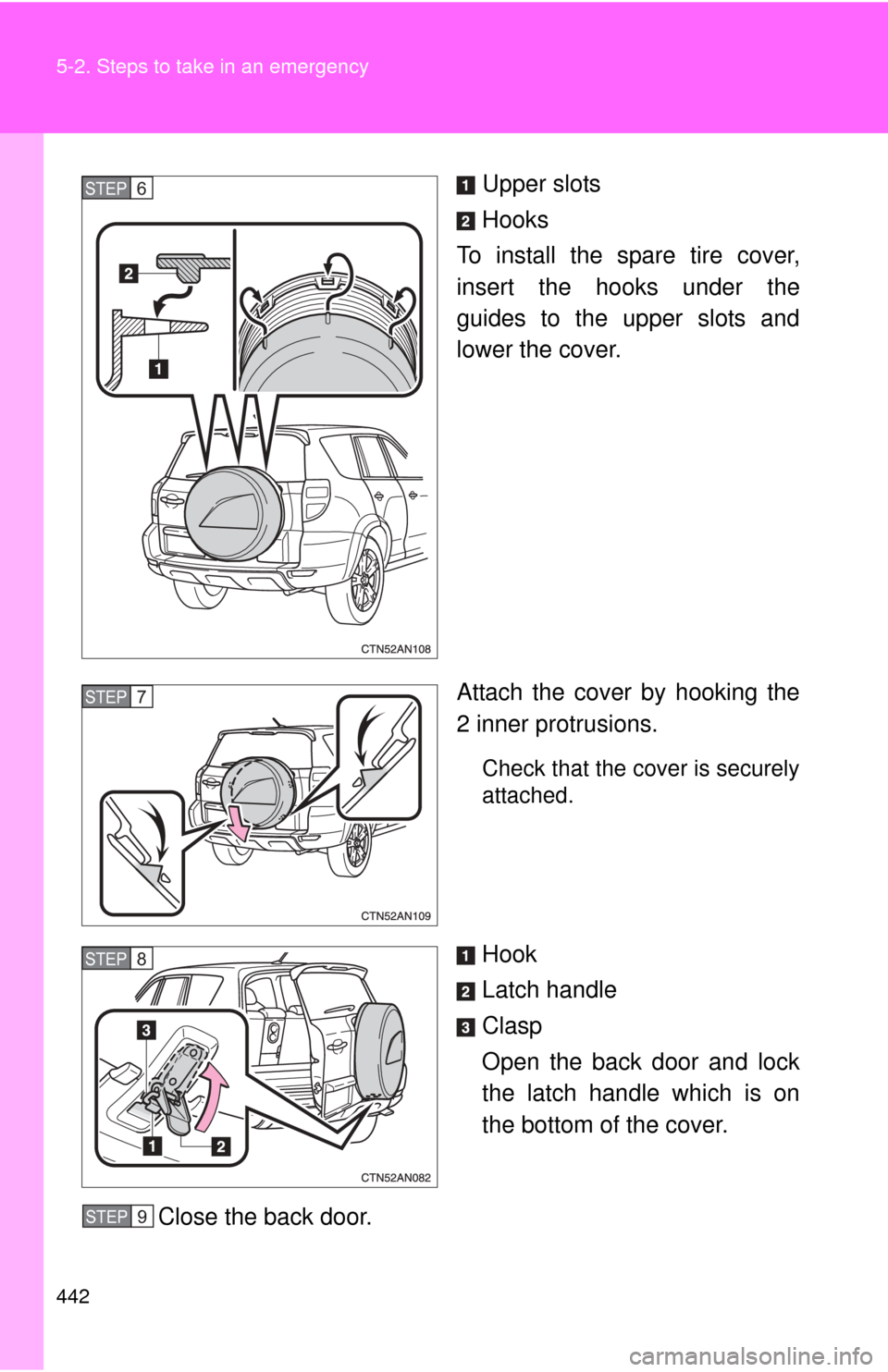
442 5-2. Steps to take in an emergency
Upper slots
Hooks
To install the spare tire cover,
insert the hooks under the
guides to the upper slots and
lower the cover.
Attach the cover by hooking the
2 inner protrusions.
Check that the cover is securely
attached.
Hook
Latch handle
Clasp
Open the back door and lock
the latch handle which is on
the bottom of the cover.
Close the back door.
STEP 6
STEP 7
STEP 8
STEP 9
Page 444 of 513
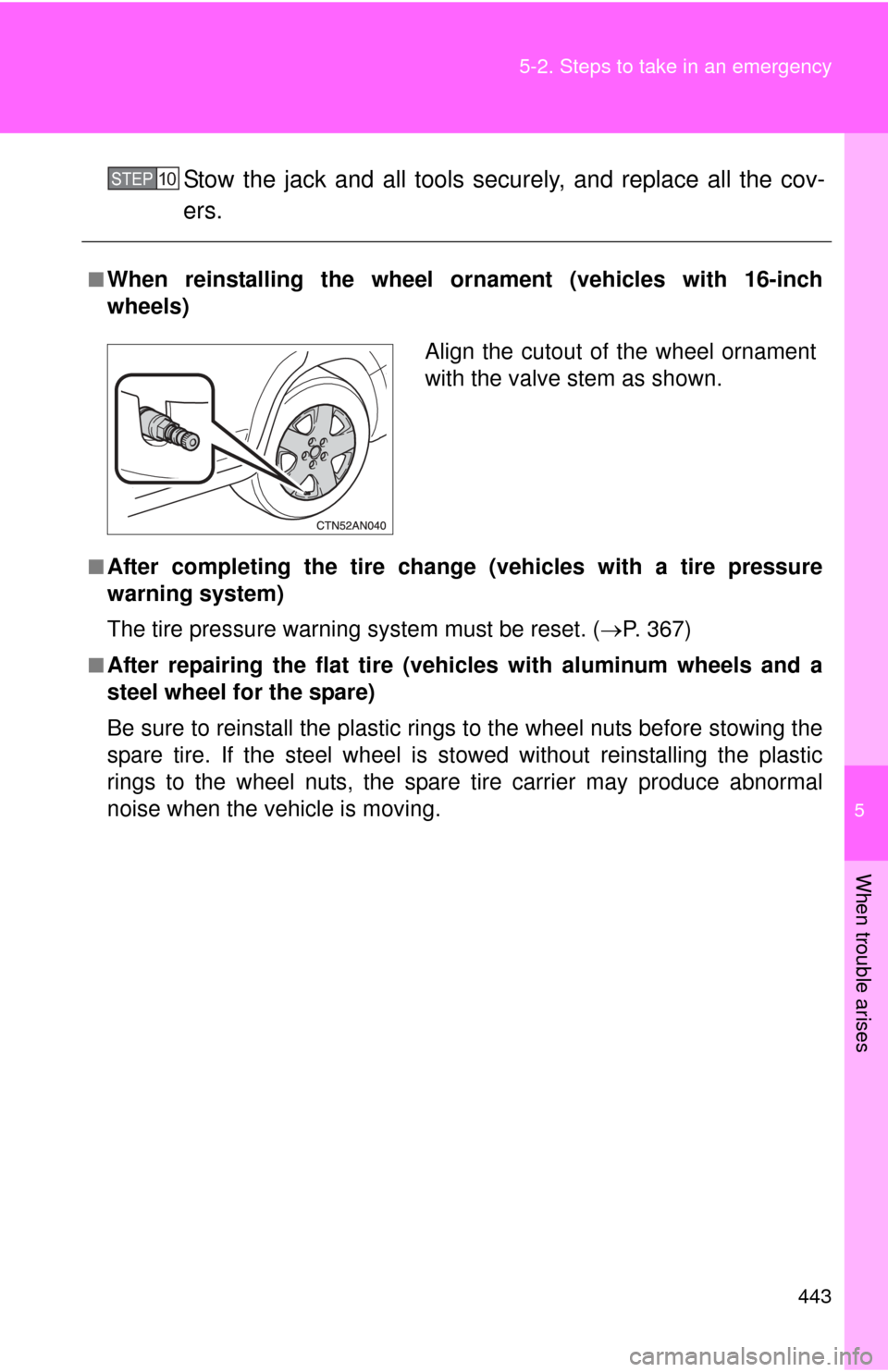
5
When trouble arises
443
5-2. Steps to take in an emergency
Stow the jack and all tools securely, and replace all the cov-
ers.
â– When reinstalling the wheel or
nament (vehicles with 16-inch
wheels)
â– After completing the tire change (vehicles with a tire pressure
warning system)
The tire pressure warning system must be reset. (ď‚®P. 367)
â– After repairing the flat tire (veh icles with aluminum wheels and a
steel wheel for the spare)
Be sure to reinstall the plastic rings to the wheel nuts before stowing the
spare tire. If the steel wheel is st owed without reinstalling the plastic
rings to the wheel nuts, the spare tire carrier may produce abnormal
noise when the vehicle is moving.
STEP 10
Align the cutout of the wheel ornament
with the valve stem as shown.
Page 445 of 513

444 5-2. Steps to take in an emergency
CAUTION
â– Using the tire jack
Improper use of the tire jack may lead to death or serious injuries due to
the vehicle suddenly falling off the jack.
â—ŹDo not use the tire jack for any purpose other than replacing tires or
installing and removing tire chains.
â—ŹOnly use the tire jack that comes with this vehicle for replacing a flat
tire.
Do not use it on other vehicles, and do not use other tire jacks for
replacing tires on this vehicle.
â—ŹAlways check that the tire jack is securely set to the jack point.
â—ŹDo not put any part of your body under the vehicle while it is supported
by the jack.
â—ŹDo not start or run the engine while your vehicle is supported by the
jack.
â—ŹDo not raise the vehicle while someone is in it.
â—ŹWhen raising the vehicle, do not put an object on or under the jack.
â—ŹDo not raise the vehicle to a hei ght greater than that required to
replace the tire.
â—ŹUse a jack stand if it is necessary to get under the vehicle.
â—ŹStop the vehicle on firm, flat and level ground, firmly set the parking
brake and put the transmission in “P”. Block the wheel diagonally
opposite to the one being changed if necessary.
Take particular care when lowering the vehicle to ensure that no one
working on or near the vehicle will be injured.
â– Using the jack handle (type B)
Insert the square head securely until you hear a click to prevent the
extension parts from coming apart unexpectedly.
Page 446 of 513

5
When trouble arises
445
5-2. Steps to take in an emergency
CAUTION
â– Replacing a flat tire
Observe the following precautions to reduce the risk of death or serious
injury:
â—ŹDo not try to remove the ornament by hand. Take due care in handling
the ornament to avoid unexpected personal injury.
â—ŹNever use oil or grease on the wheel bolts or wheel nuts.
Oil and grease may cause the wheel nuts to be excessively tightened,
leading to bolt or disc wheel damage. In addition, the oil or grease can
cause the wheel nuts to loosen and the wheel may fall off, causing a
serious accident. Remove any oil or grease from the wheel bolts or
wheel nuts.
●Have the wheel nuts tightened with a torque wrench to 76 ft•lbf (103
N
•m, 10.5 kgf•m) as soon as possible after changing wheels.
Failure to follow these precautions could cause the nuts to loosen and
the wheel may fall off, which could lead to an accident causing death
or serious injury.
â—ŹDo not attach a heavily damaged wheel ornament, as it may fly off the
wheel while the ve hicle is moving.
â—ŹMake sure that the rubber rings are not installed to the wheel nuts for
aluminum wheel. Otherwise, the nuts may become loose and the
wheel may fall off, which may cause a serious accident.
Page 447 of 513

446 5-2. Steps to take in an emergency
NOTICE
â– Do not drive the vehicle with a flat tire
Do not continue driving with a flat tire.
Driving even a short distance with a flat tire can damage the tire and the
wheel beyond repair.
â– When replacing the tires (vehicles with a tire pressure warning sys-
tem)
When removing or fitting the wheels, tires or the tire pressure warning
valve and transmitter, contact your Toyota dealer as the tire pressure
warning valve and transmitter may be damaged if not handled correctly.
â– To avoid damaging the tire pressure warning valves and transmit-
ters (vehicles with a tire pressure warning system)
Do not use liquid sealants on flat tires.
Page 448 of 513
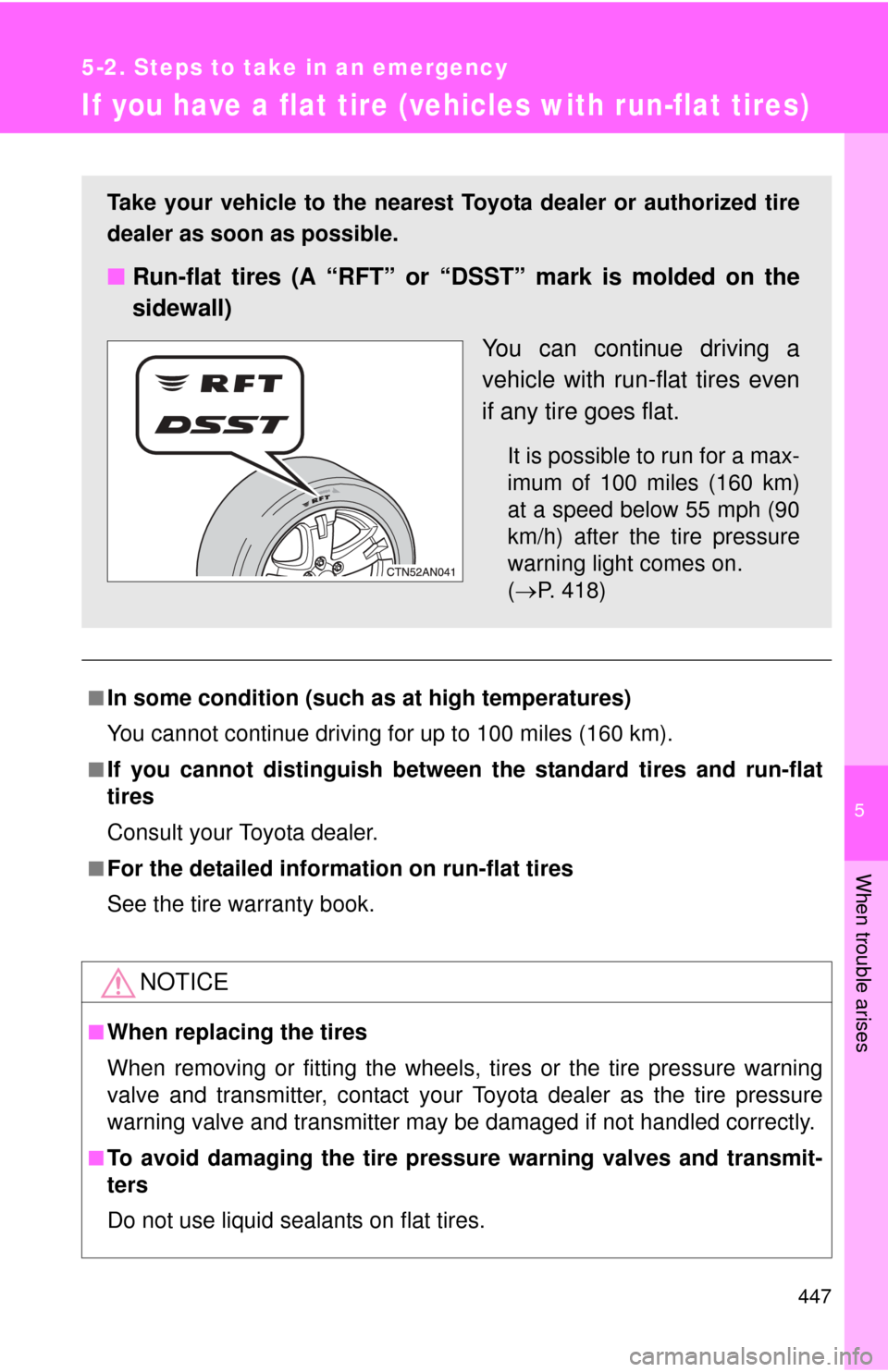
5
When trouble arises
447
5-2. Steps to take in an emergency
If you have a flat tire (vehicles with run-flat tires)
â– In some condition (such as at high temperatures)
You cannot continue driving for up to 100 miles (160 km).
â– If you cannot distinguish between the standard tires and run-flat
tires
Consult your Toyota dealer.
â– For the detailed information on run-flat tires
See the tire warranty book.
NOTICE
â– When replacing the tires
When removing or fitting the wheels, tires or the tire pressure warning
valve and transmitter, contact your Toyota dealer as the tire pressure
warning valve and transmitter may be damaged if not handled correctly.
â– To avoid damaging the tire pressure warning valves and transmit-
ters
Do not use liquid sealants on flat tires.
Take your vehicle to the nearest Toyota dealer or authorized tire
dealer as soon as possible.
■Run-flat tires (A “RFT” or “DSST” mark is molded on the
sidewall)
You can continue driving a
vehicle with run-flat tires even
if any tire goes flat.
It is possible to run for a max-
imum of 100 miles (160 km)
at a speed below 55 mph (90
km/h) after the tire pressure
warning light comes on.
(ď‚® P. 418)
Page 449 of 513
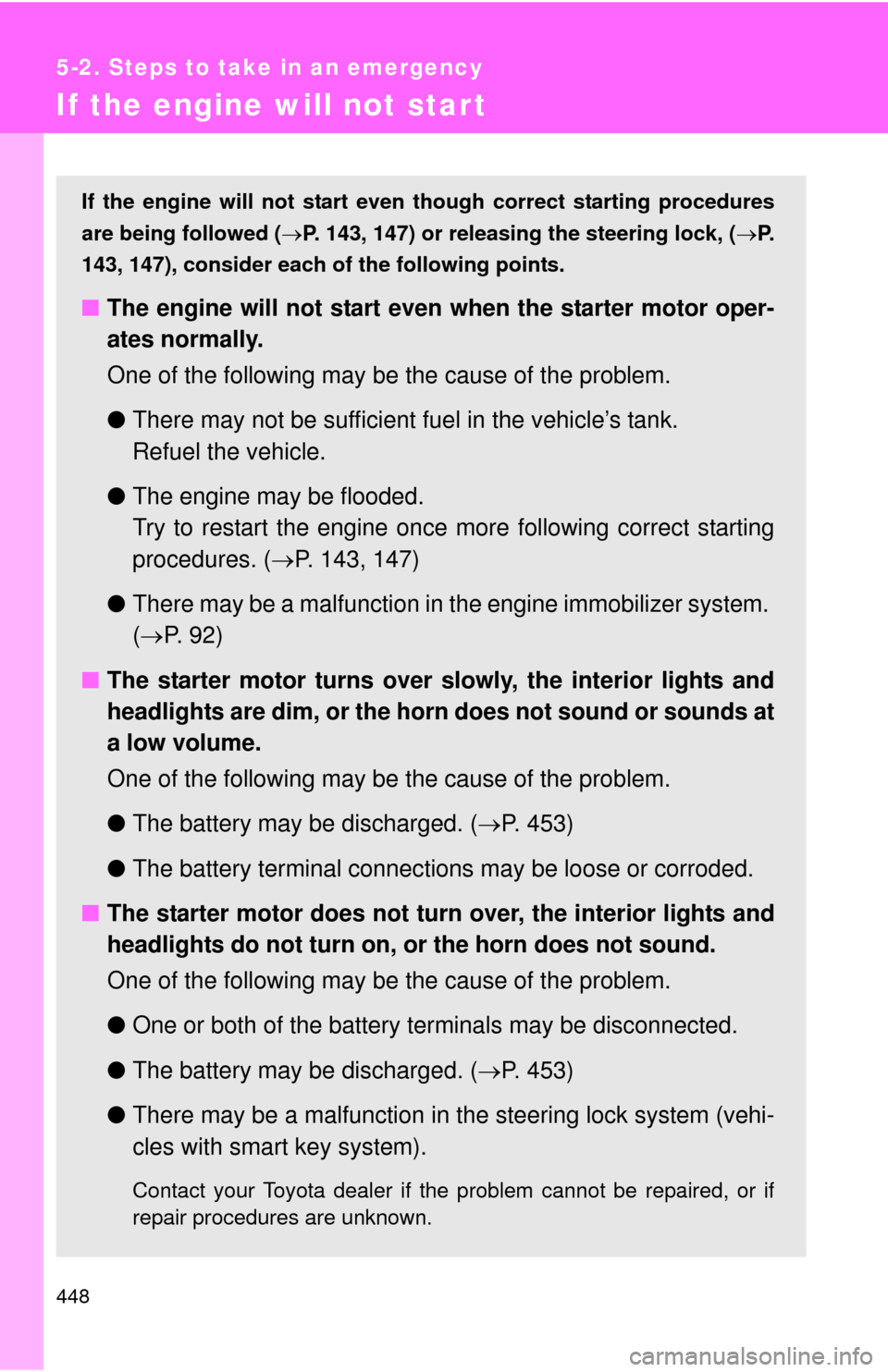
448
5-2. Steps to take in an emergency
If the engine will not star t
If the engine will not start even though correct starting procedures
are being followed (ď‚®P. 143, 147) or releasing the steering lock, ( ď‚®P.
143, 147), consider each of the following points.
â– The engine will not start even when the starter motor oper-
ates normally.
One of the following may be the cause of the problem.
●There may not be sufficient fuel in the vehicle’s tank.
Refuel the vehicle.
â—Ź The engine may be flooded.
Try to restart the engine once more following correct starting
procedures. ( ď‚®P. 143, 147)
â—Ź There may be a malfunction in the engine immobilizer system.
( ď‚® P. 9 2 )
â– The starter motor turns over slowly, the interior lights and
headlights are dim, or the horn does not sound or sounds at
a low volume.
One of the following may be the cause of the problem.
â—ŹThe battery may be discharged. ( ď‚®P. 453)
â—Ź The battery terminal connec tions may be loose or corroded.
â– The starter motor does not turn over, the interior lights and
headlights do not turn on, or the horn does not sound.
One of the following may be the cause of the problem.
â—Ź One or both of the battery terminals may be disconnected.
â—Ź The battery may be discharged. ( ď‚®P. 453)
â—Ź There may be a malfunction in the steering lock system (vehi-
cles with smart key system).
Contact your Toyota dealer if the problem cannot be repaired, or if
repair procedures are unknown.
Page 450 of 513
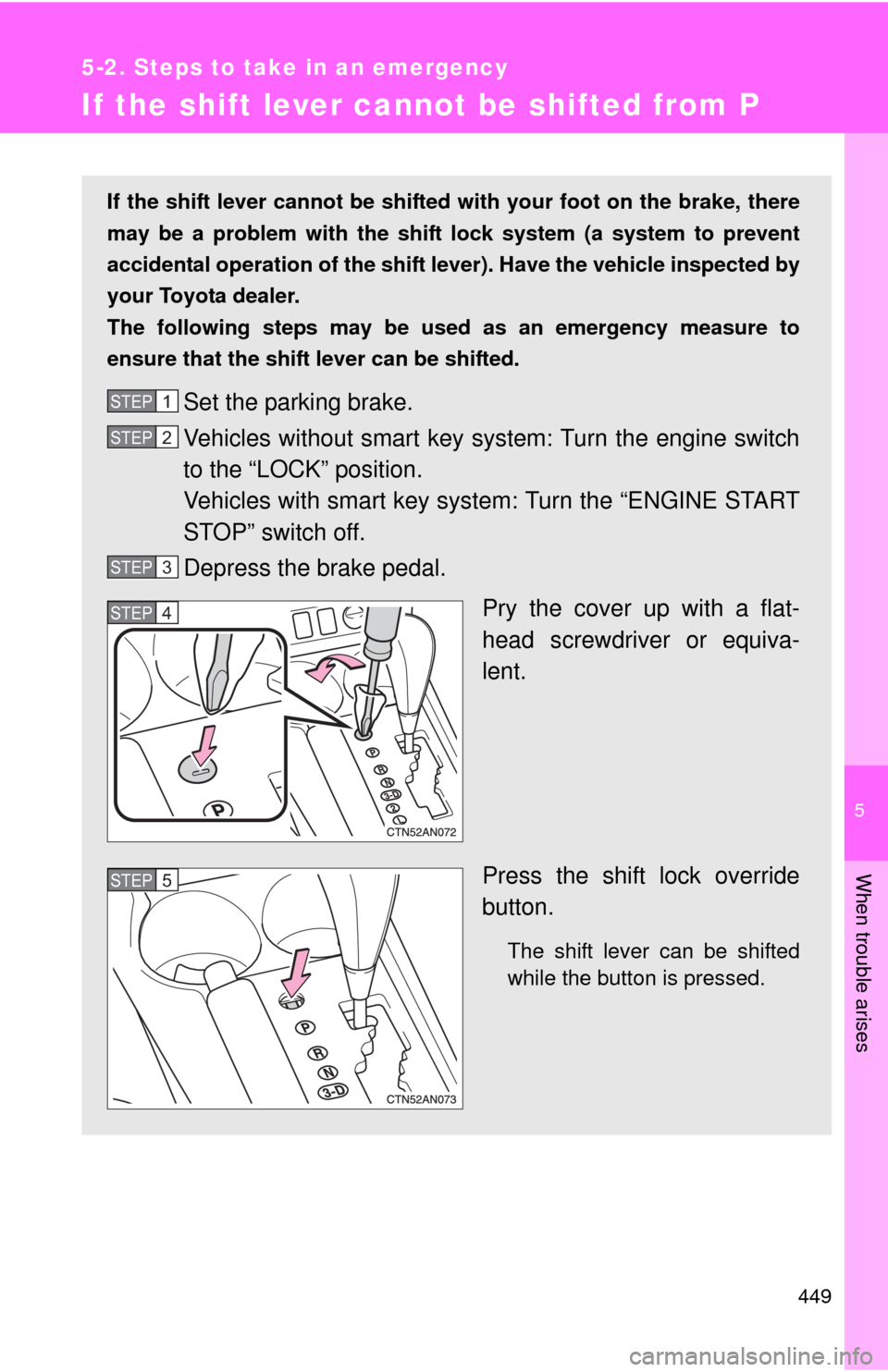
5
When trouble arises
449
5-2. Steps to take in an emergency
If the shift lever cannot be shifted from P
If the shift lever cannot be shifted with your foot on the brake, there
may be a problem with the shift lock system (a system to prevent
accidental operation of the shift lever). Have the vehicle inspected by
your Toyota dealer.
The following steps may be used as an emergency measure to
ensure that the shift lever can be shifted.
Set the parking brake.
Vehicles without smart key system: Turn the engine switch
to the “LOCK” position.
Vehicles with smart key system: Turn the “ENGINE START
STOP” switch off.
Depress the brake pedal.
Pry the cover up with a flat-
head screwdriver or equiva-
lent.
Press the shift lock override
button.
The shift lever can be shifted
while the button is pressed.
STEP 1
STEP 2
STEP 3
STEP 4
STEP 5